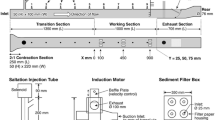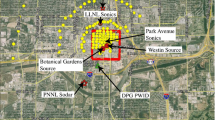Abstract
Sandstorms are frequent in the northern Chihuahuan Desert in New Mexico, an area characterized by open areas lacking vegetation, individual mesquite bushes, and mesquite coppice dunes. Field measurements of sand fluxes and wind velocities over a two year period provided a description of the area – suggesting that the “streets”, the flat, elongated, non-vegetated areas aligned with the dominant wind directions are the principal sources of wind-dispersed soil and dust. However, since soil erosion and dust movement depend on the pattern, strength, and gradients in the wind field, modeling soil erosion and dust movement requires a continuous wind velocity field. Consequently, air flow patterns at this site were simulated using a semi-empirical mass-consistent diagnostic wind field model: QUIC version 3.5 (Quick Urban & Industrial Complex). Two hundred and fifty-one simulations were run encompassing several dust storms occurring in April 2003. Wind velocity vectors were compared between the model and field data at three heights for six locations and were found to correlate well for a majority of the situations suggesting that the flow patterns are consistent throughout the domain. In particular, good agreement was found for wind speeds at 0.75 m, the height for which the model was tuned. However, it overestimated velocities at 1.5 m (10%) and 3.15 m (13%). Generally, the model successfully identified locations of the highest wind velocities and wind stresses, predominately found in “streets” aligned with the driving wind, and locations of wake flow downwind of mesquite bushes where there was separation flow or otherwise shelter from the wind.
Similar content being viewed by others
References
Okin, G.S., Gillette, D.A. and Herrick, J.E.: (2006), Multiscale controls on and consequences of Aeolian processes in landscape change in arid and semiarid environments, J. Arid Environ. (in press).
G.S. Okin D.A. Gillette (2001) ArticleTitleDistribution of vegetation in wind-dominated landscapes: Implications for wind erosion modeling and landscape processes J. Geophys. Res. 106 9673–9683 Occurrence Handle10.1029/2001JD900052
Gillette, D., Herrick, J. and Herbert, G.: 2006, Wind characteristics of mesquite streets in the Northern Chihuahuan Desert, New Mexico, USA, Environ. Fluid Mech. (in press).
Gillette, D. and Pitchford, A.: 2004, Sand flux in the northern Chihuahuan Desert, New Mexico, USA, and the influence of mesquite-dominated landscapes, J. Geophys. Res. 109, 1–12, F04003, doi:10.1029/2003JF000031.
Pardyjak, E. and Brown, M.: 2001, Evaluation of a fast-response urban wind model – comparison to single-building wind-tunnel data, Int. Soc. Environ. Hydraulics, Tempe, AZ, Dec. 2001, LA-UR-01-4028, 6 pp.
Pardyjak, E. and Brown, M.: 2002, Fast response modeling of a two building urban street canyon, 4th AMS Symposium on the Urban Environment, Norfolk, VA, May 20–24, LA-UR-02-1217.
Williams, M., Brown, M., Boswell, D., Singh, B. and Pardyjak, E.: 2004, Testing of the QUIC-PLUME model with wind-tunnel measurements for a high-rise building, Fifth Symposium on the Urban Environment, Vancouver, B.C., Canada, LA-UR-04-4296, 10 pp.
Bowker, G.E., Perry, S.G. and Heist, D.K.: 2004, A Comparison of Airflow Patterns From the QUIC Model and an Atmospheric Wind Tunnel for a Two-Dimensional Building Array and a Multi-Block Region Near the World Trade Center Site. Fifth Symposium on the Urban Environment/13th Conference on the Applications of Air Pollution Meteorology with the Air and Waste Management Association, Vancouver, B.C., Canada.
H.B. Musick D.A. Gillette (1990) ArticleTitleField evaluation of relationships between a vegetation structural parameter and sheltering against wind erosion, Land Degrad Rehabil. 2 87–94
M.R. Raupach D.A. Gillette J.F. Leys (1993) ArticleTitleThe effect of roughness elements on wind erosion threshold J. Geophys. Res. 98 3023–3029 Occurrence Handle10.1029/92JD01922
V. Wyatt W.G. Nickling (1997) ArticleTitleDrag and shear stress partitioning in sparsely vegetated desert canopies Earth Surf. Processes Landforms 21 607–620
N. Lancaster A. Baas (1998) ArticleTitleInfluence of vegetation on sand transport by wind: Field studies at Owens Lake, California Earth Surf. Processes Landforms 23 69–82 Occurrence Handle10.1002/(SICI)1096-9837(199801)23:1<69::AID-ESP823>3.0.CO;2-G
Grant, P.F. and Nickling, W.G.: 1998, Direct field measurements of wind drag on vegetation for application to windbreak design and modeling, Land Degrad. Dev. 9, 57-66.
Gillies, J.A., Nickling, W.G. and King, J.: 2002, Drag coefficient and plant form-response to wind speed in three plant species: Burning Bush (Euonymus alatus), Colorado Blue Spruce (Picea pungens glauca.), and Fountain Grass (Pennisetum setaceum), J. Geophys. Res. Atmos. 107(D24), 10–1 – 10–15, 4760, doi:10.1029/2001JD001259.
A. Frank G. Kocurek (1996) ArticleTitleAirflow up the stoss slope of sand dunes: Limitations of current understanding Geomorphology 17 47–54 Occurrence Handle10.1016/0169-555X(95)00094-L
N. Lancaster W.G. Nickling C. McKenna Neuman V. Wyatt (1996) ArticleTitleSediment flux and airflow on the stoss slope of a barchan dune Geomorphology 17 55–62 Occurrence Handle10.1016/0169-555X(95)00095-M
Nickling, W.G. and McKenna Neuman, C.: 1999, Recent investigations of airflow and sediment transport over desert dunes, In: A. Goudie, I. Livingstone and S. Stokes (eds.), Aeolian Envrironments and Landforms, Wiley and Sons, Chichester.
I.J. Walker W.G. Nickling (2002) ArticleTitleDynamics of secondary airflow and sediment transport over in the lee of transverse dunes. Prog. Phys. Geogr. 25 47–75 Occurrence Handle10.1191/0309133302pp325ra
Parsons, D.R., Wiggs, G.F.S., Walker, I.J., Garvey, B.G. and Ferguson, R.I.: 2002, Time-averaged numerical model ing of airflow over an idealized transverse dune, In: J.A. Lee and T.M. Zobeck (eds.), Fifth International Conference on Aeolian Research/GCTE-SEN Joint Conference, International Center for Arid and Semi-Arid Land Studies, Texas Tech University, Lubbock Texas, USA, Special Publication 02–2, pp. 261–267.
C.H.B. Priestly (1959) Turbulent Transfer in the Lower Atmosphere University of Chicago Press Chicago
D.A. Gillette W.A. Chen (2001) ArticleTitleParticle production and aeolian transport from a ‘supply limited’ source area in the Chihuahuan Desert, New Mexico, United States J. Geophys. Res. 106 5267–5278 Occurrence Handle10.1029/2000JD900674
Marticorena, B., Bergametti, G., Gillette, D.A. and Belnap, J.: 1997, Factors controlling threshold friction velocity in semiarid and arid areas of the United States, J. Geophys. Res. 102, 23,277–23,287.
P.R. Owen (1964) ArticleTitleSaltation of uniform grains in air J. Fluid Mech. 20 225–242 Occurrence Handle10.1017/S0022112064001173
S. Vogel (1989) ArticleTitleDrag and reconfiguration of broad leaves in high winds J. Exper. Bot. 40 941–984
Gillies, J.A., Lancaster, N., Nickling, W.G. and Crawley, D.: 2000, Field determination of drag forces and shear stress partitioning effects for a desert shrub (Sarcobatus vermiculatus, Greasewood), J. Geophys. Res. 105(D20), 24, 871–24, 880.
Author information
Authors and Affiliations
Corresponding author
Additional information
The research presented here was performed under the Memorandum of Understanding between the U.S. Environmental Protection Agency (EPA) and the U.S. Department of Commerce’s National Oceanic and Atmospheric Administration (NOAA) and under agreement number DW13921548. This work constitutes a contribution to the NOAA Air Quality Program. Although it has been reviewed by EPA and NOAA and approved for publication, it does not necessarily reflect their policies or views. U.S. Government right to retain a non-exclusive royalty-free license in and to any copyright is acknowledged.
Rights and permissions
About this article
Cite this article
Bowker, G.E., Gillette, D.A., Bergametti, G. et al. Modeling Flow Patterns in a Small Vegetated Area in the Northern Chihuahuan Desert using QUIC (Quick Urban & Industrial Complex). Environ Fluid Mech 6, 359–384 (2006). https://doi.org/10.1007/s10652-005-6021-8
Received:
Accepted:
Issue Date:
DOI: https://doi.org/10.1007/s10652-005-6021-8




